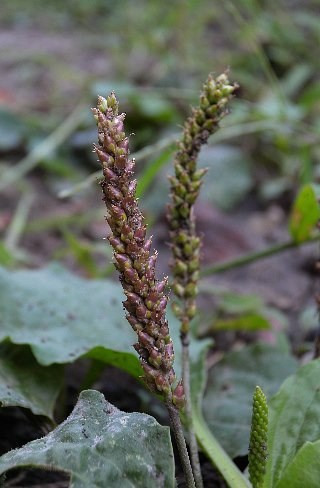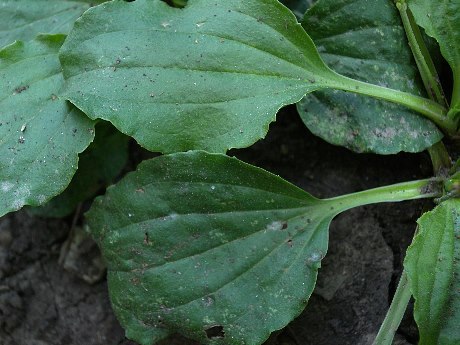Description:
This
herbaceous perennial plant is consists of a low rosette of basal leaves
about 5-12" across, from which one or more flowering stalks develop.
The blades of the basal leaves are 2-5" long and 1½–3" across; they are
oval in shape with about 5 parallel veins and smooth margins. The upper
surface of each blade is medium green and glabrous to sparsely
canescent, while the lower surface of each blade is light green and
sometimes finely pubescent along the veins. The petioles are a little
shorter than their blades, light green, and usually glabrous. The upper
surface of each petiole has a concave groove along its length. The
flowering stalks are 4-20" long, unbranched, and more or less erect.
The lower one-third of each stalk is green, terete, glabrous to
finely
pubescent, and naked; a narrowly cylindrical spike of greenish flowers
occurs along the upper two-thirds of each stalk. These small flowers
are densely distributed along the spike. Each flower is only 1/8" (3
mm.)
long, consisting of 4 green sepals, a pistil with a single white
style, 4 stamens with pale purple anthers, and a papery corolla with 4
spreading lobes. Each sepal has a green keel and membranous margins; it
is
ovate to oval in shape (including the margins). The tiny lobes of the
corolla are lanceolate in shape and smaller than the sepals. At the
base of each flower, there is a green bract that is ovate to oval in
shape and about the same length as the sepals. The blooming period can
occur from early summer to early fall. A single floral spike remains in
bloom for about 2 weeks, but the same plant can produce a succession of
spikes that bloom at different times of the year. Furthermore, some
plants produce their spikes earlier or later than others. The flowers
are wind-pollinated. The flowers are replaced by ovoid seed capsules
that are individually about 3 mm. long at maturity; they are initially
green, but later become purple or brown. Each seed capsule is
circumsessile and splits open around the middle to release the seeds.
Each capsule contains about 6-15 seeds. The seeds are 1.0–1.5 mm. long,
light to dark brown, and somewhat flattened; the seed surface is finely
reticulated (requires 10x hand lens to see). The root system consists
of a short crown with fibrous roots.
green, terete, glabrous to
finely
pubescent, and naked; a narrowly cylindrical spike of greenish flowers
occurs along the upper two-thirds of each stalk. These small flowers
are densely distributed along the spike. Each flower is only 1/8" (3
mm.)
long, consisting of 4 green sepals, a pistil with a single white
style, 4 stamens with pale purple anthers, and a papery corolla with 4
spreading lobes. Each sepal has a green keel and membranous margins; it
is
ovate to oval in shape (including the margins). The tiny lobes of the
corolla are lanceolate in shape and smaller than the sepals. At the
base of each flower, there is a green bract that is ovate to oval in
shape and about the same length as the sepals. The blooming period can
occur from early summer to early fall. A single floral spike remains in
bloom for about 2 weeks, but the same plant can produce a succession of
spikes that bloom at different times of the year. Furthermore, some
plants produce their spikes earlier or later than others. The flowers
are wind-pollinated. The flowers are replaced by ovoid seed capsules
that are individually about 3 mm. long at maturity; they are initially
green, but later become purple or brown. Each seed capsule is
circumsessile and splits open around the middle to release the seeds.
Each capsule contains about 6-15 seeds. The seeds are 1.0–1.5 mm. long,
light to dark brown, and somewhat flattened; the seed surface is finely
reticulated (requires 10x hand lens to see). The root system consists
of a short crown with fibrous roots.
Cultivation: Common
Plantain prefers full or partial sun, moist to mesic conditions, and
soil containing loam or clay loam. It tolerates considerable compaction
of the soil, but the size of individual plants will be somewhat
smaller. Individual seeds can remain viable for up to 60 years and
require light to germinate.
Range & Habitat:
Common Plantain is common in NE Illinois, occasional to locally common
in central Illinois, and occasional to absent elsewhere in the state
(see Distribution
Map). It is likely that this plant is more widely distributed
than official records indicate. Common Plantain was introduced from
Europe and it is
widely distributed across the continent of North America. Habitats
include lawns, mowed roadsides, compacted soil along paths, vacant
lots, and waste areas. Areas with a history of human-related
disturbance are preferred. This plant is more common in urban and
residential areas
than elsewhere.
Faunal Associations:
Because the flowers are wind-pollinated, they attract few insect
visitors. However, Syrphid flies sometimes feed on the pollen. The
caterpillars of the butterfly Junonia coenia
(Buckeye) and several species of moth feed on plantains (Plantago spp.). Other insect feeders include Dysaphis plantaginea
(Rosy Apple Aphid), Dibolia borealis (Northern Plantain Flea Beetle), Listronotus oregonensis (Carrot Weevil), larvae of Phytomyza plantaginis (a leaf-miner fly species),
and Melanoplus bivittatus (Two-Striped
Grasshopper); see the Insect Table for a more complete list of species. Cardinals, Grasshopper Sparrows, and probably other birds
feed on either the seeds or seed capsules to a minor extent; the Ruffed
Grouse occasionally eats the leaves. The leaves and flowering
stalks of Common Plantain are readily consumed by groundhogs, rabbits,
deer, cattle, sheep, and other mammalian herbivores.

Photographic
Location:
A lawn on the campus of the University of Illinois in Urbana, Illinois.
Comments:
This is a common lawn weed that is able to resist mowing because of its
low basal leaves. Even stunted specimens of this plant can produce
small flowering spikes. Common Plantain is very similar in appearance
to the native Plantago rugelii (Black-Seeded
Plantain), which is another common lawn weed. The easiest way to
distinguish these two species involves an examination of the seed
capsules on a a mature floral spike (one that has become purple or
brown). Common Plantain has ovoid seed capsules that split open around
the middle at maturity. In contrast, Black-Seeded Plantain has
oblongoid seed capsules that split open toward the bottom at maturity.
By applying pressure with the fingers, it is possible to split open the
seed capsules a little prematurely. These two species also differ in
the appearance of their seeds and the shape of their sepals.